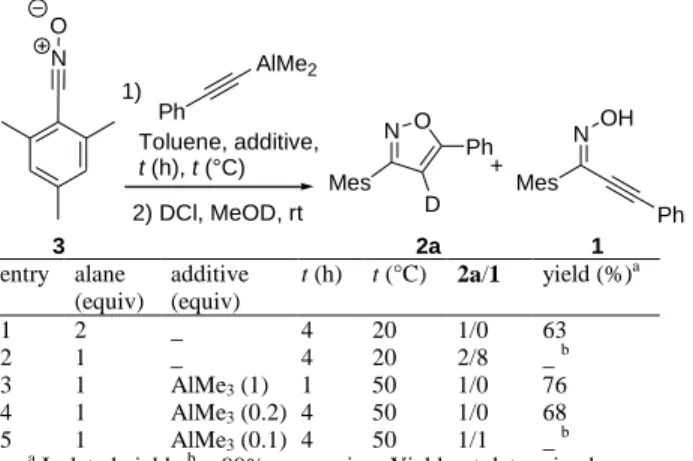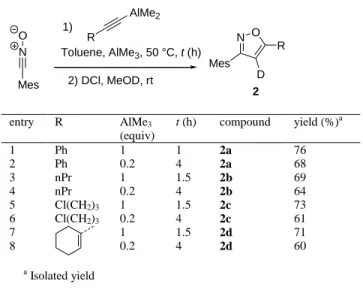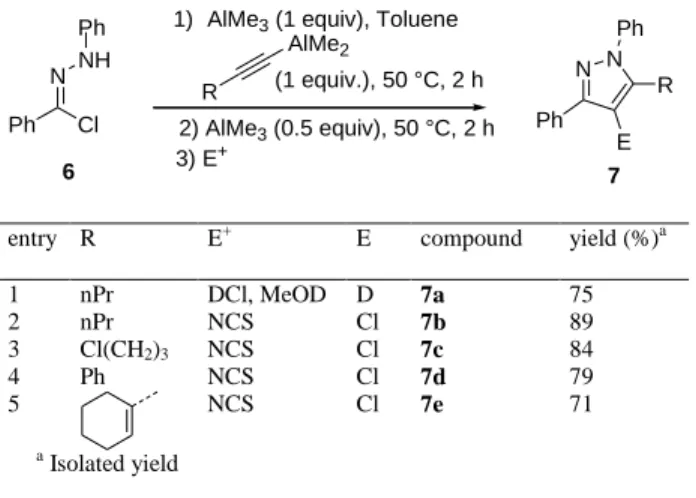HAL Id: hal-02185376
https://hal.archives-ouvertes.fr/hal-02185376
Submitted on 17 Jul 2019
HAL is a multi-disciplinary open access
archive for the deposit and dissemination of
sci-entific research documents, whether they are
pub-lished or not. The documents may come from
teaching and research institutions in France or
abroad, or from public or private research centers.
L’archive ouverte pluridisciplinaire HAL, est
destinée au dépôt et à la diffusion de documents
scientifiques de niveau recherche, publiés ou non,
émanant des établissements d’enseignement et de
recherche français ou étrangers, des laboratoires
publics ou privés.
Direct Synthesis of Polysubstituted Aluminoisoxazoles
and Pyrazoles by a Metalative Cyclization
Olivier Jackowski, Thomas Lecourt, Laurent Micouin
To cite this version:
Olivier Jackowski, Thomas Lecourt, Laurent Micouin. Direct Synthesis of Polysubstituted
Alumi-noisoxazoles and Pyrazoles by a Metalative Cyclization. Organic Letters, American Chemical Society,
2011, 13 (20), pp.5664-5667. �10.1021/ol202389u�. �hal-02185376�
Direct Synthesis of
polysubstituted
aluminoisoxazoles and pyrazoles
by a Metalative Cyclization.
Olivier Jackowski, Thomas Lecourt, Laurent Micouin*
UMR8638, CNRS-Paris Descartes University, Faculté de Pharmacie, 4 av. de l'Observatoire, 75006 Paris, France.Laurent.micouin@parisdescartes.fr
Received Date (will be automatically inserted after manuscript is accepted)
ABSTRACT N XH N X R1 "Al" R2 Cl R1 E+ N X R1 E R2 R2 AlMe2 AlMe3, Toluene X = O, NR3
Alumino-heteroles are obtained from simple precursors in a fully chemo and regio-selective manner by a metalative cyclization. The carbon-aluminum bond is still able to react further with several electrophiles, without the need of transmetalation. This synthetic route provides a novel entry to heterocyclic organoaluminum reagents as well as a straightforward access to 3,4,5 trisubstituted isoxazoles and 1,3,4,5 tetrasubstituted pyrazoles.
The preparation of main-group aryl and heteroaryl organometallics is a very active field, as these reagents are key intermediates in diversity-oriented elaboration of compounds for pharmaceutical and material science applications.1 In this context, the preparation of aryl- or
heterocyclic organoaluminum reagents has gained a renewed interest, due to their potential broad functional tolerance, 2 and the low cost and toxicity of alanes.3
A conventional preparative method for aromatic organoaluminum compounds has been the transmetalation of the corresponding lithium or magnesium derivatives with various aluminum(III) sources,4 or in some cases
trough aluminum-tin or boron exchange reactions.5
However, the transmetalation pathway, generally conducted at low temperature from reactive organolithium reagents,6 generates salts as side products. These salts
have been reported to strongly affect the reactivity7 of the
final organoaluminum reagent and the enantioselectivity of asymmetric processes.8 This procedure is very often
conducted in ethereal solvents, known to strongly decrease the Lewis acidity of organoaluminum reagents, and therefore to affect their reactivity. Finally, the potential functional group tolerance of the
carbon-aluminum bond cannot be exploited if organocarbon-aluminum reagents are prepared from the corresponding lithiated or magnesiated derivatives.9
More recently, several alternative procedures, based on directed metalation10 or oxidative insertion2 have been
reported, leading to functionalized aromatic
organoaluminum compounds. However, in most cases, these organometallic reagents must be transmetalated before further reaction. New alternative routes to aluminated heterocycles is therefore desirable.
In our on-going work in the field of organoaluminum chemistry,11 we have reported the preparation of
functional aluminotriazoles by a copper catalysed cycloaddition of organic azides and mixed aluminium acetylides.12 Herein, we report that aluminated heteroles
can be prepared by a tandem addition/intramolecular 5 endo-dig metalative cyclization mechanism (Figure 1). This kind of cyclization is well precedented for transition-metal catalysed synthesis of various heterocycles13 and it
has been shown that a stoichiometric amount of metalated precursor can lead to metalated benzoheteroles in an efficient manner.14 However, despite these examples, such
a pathway has never been used to prepare aluminated heterocycles.
XY M X Y
M
Figure 1. General principle of metalated heterocycles synthesis
by a metalative cyclization process
We first turned our attention on aluminated isoxazoles synthesis. Isoxazole is indeed a privileged structure encountered in numerous compounds with biological activities, natural products and functional materials.15
Furthermore, acces to these structures from alkynyloxime
using catalytic16 or stoichiometric electrophilic
activation17 is well documented.
Scheme 1. Metalative cyclisation of oxime 1
Ph N OH 1 AlMe3 (2 equiv) 1) Toluene, 50°C, 2 h 2) DCl, MeOD, rt N O D Ph 2a (60% D) 92 %
Cyclization product 2a was indeed obtained in 92% yield, starting from compound 1 in the presence of 2 equivalents of trimethylaluminum. However, only partial (60%) deuterium incorporation was observed. This modest deuterium incorporation can be explained by a competitive in situ protonation of the aluminated intermediate.18 In order to avoid this troublesome
side-reaction, we decided to generate the metallated precursor directly from nitrile oxide 3. Although nitrile oxides are not considered as electrophiles, complexation to aluminum reagents could increase their electrophilicity and decrease their dipole reactivity, as already noticed by
Kanemasa and co-workers.19 To our delight, 93%
deuterated isoxazole 2a was obtained with 2 equivalents of dimethyl-phenylalkynylaluminum20 and mesitylene
carbonitrile oxide, after deuterolysis of the reaction mixture (Table 1, entry 1). The use of only one equivalent of aluminium acetylide led to the formation of alkynyl oxime 1 as major reaction product (entry 2), showing that external electrophilic assistance is required to triger the cyclization. Thus, addition of one equivalent of AlMe3
after initial reaction between nitrile oxide and aluminum acetylide resulted in the clean formation of compound 2a in 76% isolated yield (Table 1, entry 3). Interrestingly, even a substoichiometric amount of AlMe3 can assist the
reaction, although 20% are needed to achieve a correct conversion (entry 4).
Table 1. Optimization of the reaction conditions
N O Ph AlMe2 1) Toluene, additive, t (h), t (°C) 2) DCl, MeOD, rt N O Mes D Ph Mes Ph N OH + 2a 1 3 entry alane (equiv) additive (equiv) t (h) t (°C) 2a/1 yield (%)a 1 2 _ 4 20 1/0 63 2 1 _ 4 20 2/8 _ b 3 1 AlMe3 (1) 1 50 1/0 76 4 1 AlMe3 (0.2) 4 50 1/0 68 5 1 AlMe3 (0.1) 4 50 1/1 _ b a
Isolated yield. b > 99% conversion. Yield not determined.
All these experiments support a tandem
addition/intramolecular 5 endo-dig metalative cyclization mechanism (Scheme 2).21 Although the role of aluminium
-acidity is well known in carbo- and hydroalumination reactions, and several examples have been reported showing that aluminum derivatives can trigger a trans addition on a triple bond,22 this intramolecular trans-hydroxyalumination is, to the best of our knowledge, unprecedented.
Scheme 2. Proposed mechanistic pathway
N AlMe2 Ph O + NO AlMe2 Ph N AlMe3 O Ph AlMe2 N AlMe2 O Ph AlMe3
Optimized experimental conditions were then applied to a variety of dimethylaluminum alkynides bearing aromatic, alkyl, chloroalkyl and alkenyl groups (Table 2). In all the cases, the 3,5-disubstitued 4-metalated isoxazoles were obtained as unique regioisomers, with more than 94% deuterium incorporation at the mechanistically expected 4 position after deuterolysis.
Table 2. Scope of the reaction: alkyne Mes N O R AlMe2 1) Toluene, AlMe3, 50 °C, t (h) 2) DCl, MeOD, rt N O Mes D R 2 entry R AlMe3 (equiv) t (h) compound yield (%)a 1 2 Ph Ph 1 0.2 1 4 2a 2a 76 68 3 nPr 1 1.5 2b 69 4 nPr 0.2 4 2b 64 5 6 7 8 Cl(CH2)3 Cl(CH2)3 1 0.2 1 0.2 1.5 4 1.5 4 2c 2c 2d 2d 73 61 71 60 a Isolated yield
Variation of the nitrile-oxide part was then investigated. As unhindered nitrile-oxides are notoriously unstable,23 the formation of aluminated isoxazoles was
attempted starting from aromatic (Table 3, entries 1-4) or aliphatic (Table 3, entry 5) hydroximoyl chlorides. Best results were obtained using one equivalent of trimethylaluminum, followed by one equivalent of mixed acetylides, leading to the clean formation of several metalated isoxazoles. Interestingly, non only aromatic, but also aliphatic- substituted isoxazoles can be obtained in a fully regioselective manner (Table 3, entry 5).
Table 3. Scope of the reaction: oxime
NOH R'
AlMe2
1) AlMe3 (1 equiv), Toluene
N O R D R' 4 (1 equiv), 50°C, 1 h Cl R 2) DCl, MeOD, rt
entry R R' compound yield (%)a
1 2 4-Cl-Ph 4-Cl-Ph Ph nPr 4a 4b 70 68 3 4-MeO-Ph nPr 4c 53 4 Ph nPr 4d 73 5 Ph(CH2)2 nPr 4e 74 a Isolated yield
The reactivity of these new aluminated heterocycles was explored (Scheme 3). Thus, compounds 5a and 5b could be obtained by reaction with several N-halo-succinimides. Once again, mesitylene carbonitrile oxide proved to be a valuable electrophile, leading to compound 5c in 65% yield. Introduction of a primary amide functional group could also be realized using a reagent recently proposed by Knochel for the functionalization of
organozinc halides.24 Although aryl and/or heteroaryl
organoaluminum species are generally transmetallated before further reaction, these two last examples clearly show that a C-C bound formation from aluminated isoxazoles can be performed without the help of any other metal source.
Scheme 3. Reactivity of aluminated isoazolesa
NOH N O R "Al" nPr Cl R N O Cl nPr 5a (91%) Cl N O I nPr 5b (57%) N O nPr 5c (65%) Cl N O nPr 5d (70%) HON O NH2 Cl AlMe3 Pr AlMe2 50 °C, 1 h NCS rt, 4 h NIS, rt, 12 h 3 rt, 7 h N C O Cl3C 12 h, then K2CO3, MeOH
Thus, this regioselective one-pot 3 components reaction is, to our opinion, a valuable alternative to the direct cycloaddition of nitrile oxides with internal alkynes. This reaction indeed generally suffers from low yield and regioselectivity unless appropriate alkynes, nitrile-oxide precursors and/or subtle kinetically controlled reaction conditions are chosen.25
Finally, extension of this metalative cyclization reaction to the synthesis of aluminated pyrazoles starting from compound 6 was briefly investigated (Table 4). After experimental conditions optimisation, we found that an additional amount of 0.5 equiv of trimethylaluminum was necessary to achieve good conversion into the metalated pyrazole. Thus, deuterated pyrazole (91% D) 7a was obtained in 75% yield as a single regioisomer (Table 4, entry 1) . Chlorination using N-chlorosuccinimide (NCS) enabled the preparation of chlorinated compounds 7b-e (Table 4, entries 2-5), showing that aluminated trisubstituted pyrazoles can also be prepared using a metalative cyclisation reaction.
Table 4. Extension to the synthesis of aluminated pyrazoles
N NH
R
AlMe2
1) AlMe3 (1 equiv), Toluene
N N Ph E R 7 (1 equiv.), 50 °C, 2 h Cl Ph 3) E+ Ph 2) AlMe3 (0.5 equiv), 50 °C, 2 h Ph 6
entry R E+ E compound yield (%)a
1 2 nPr nPr DCl, MeOD NCS D Cl 7a 7b 75 89 3 Cl(CH2)3 NCS Cl 7c 84 4 Ph NCS Cl 7d 79 5 NCS Cl 7e 71 a Isolated yield
In conclusion, we have developed an access to polysubstituted alumino-heteroles, based on a metalative cyclization. The regioselectivity of this reaction, combined with the reactivity of the final organoaluminum compounds, enables a rapid and simple access to 3,4,5-trisubstituted isoxazoles with three points of variation introduced in the same operation. We have also shown that this reaction can be extended to the preparation of the corresponding 1,3,5-trisubstituted 4-aluminopyrazoles. More generally, this synthetic pathway provides an alternative entry to complex heterocyclic organoaluminum reagents, with unexplored reactivity. We expect the present strategy to be applicable to other heterocyclic systems.
Acknowledgment Financial support from ANR (ANR blanc AluMeth) is acknowledged
Supporting Information Available Experimental procedures and characterization of compounds 2a-d, 4a-e, 5a-d, 7a-e. This material is available free of charge via the Internet at http://pubs.acs.org.
(1) (a) Handbook of Functionnalized Organometallics (Ed. P. Knochel), WILEY-VCH, Weinheim, 2005. (b) Chinchilla, R.; Najera, C.; Yus, M. Chem. Rev. 2004, 104, 2667.
(2) Blümke, T.; Chen, Y.-H.; Peng, Z.; Knochel, P. Nature Chem. 2010, 2, 313.
(3) Although organoaluminum reagents are usually regarded as hazardous reagents, their pyrophoric character is mainly a problem with low-molecular weight reagents, such as trimethylaluminum, and is drastically reduced when working with diluted solutions in hydrocarbons. The non-pyrophoric limits for trimethylaluminum are 11 wt% in hexane and 14 wt% in heptane : (a) Suzuki, K.; Nagasawa, T. In Encyclopaedia of Reagents for Organic
Synthesis; Paquette L. A., Ed., John Wiley &Sons Ltd: Chichester,
1995; Vol. 7, 5186. Thus, commercially available 2M solution of trimethylaluminum in heptane can be handled like a commercially available MeLi or BuLi solution. This is confirmed by comparable safety data sheets hazards identification according to EC regulations between these reagents. In this work, we only used commercially available 2M solutions of trimethylaluminum. For a discussion on this problem, see also: Von Zezschwitz, P. Synthesis, 2008, 1809.
(4) (a) Eisch, J. J. In Comprehensive Organometallic Chemistry, Wilkinson, G; Stone, F. G. A.; Abel, E. W., Eds., Pergamon: Oxford, 1982; Vol. 1, 555. (b) Ishikawa, T.; Ogawa, A.; Hirao, T. J. Am. Chem.
Soc. 1998, 120, 5124. (c) Hawner, C. ; Li, K.; Cirriez, V.; Alexakis, A. Angew. Chem. Int. Ed. 2008, 47, 8211.
(5) (a) Eisch, J. J.; Mackenzie, K.. Windisch, H.; Krüger, C. Eur. J.
Inorg. Chem. 1999, 153. (b) Tschinkl, M.; Bachmann, R. E.; Gabbaï, F.
P.; Chem. Commun. 1999, 1367. (c) Bochmann, M.; Sarfield, M. J.
Organometallics 1998, 17, 4684.
(6) Gao, F.; Lee, Y.; Mandai, K.; Hoveyda, A. H. Angew. Chem. Int.
Ed. 2010, 49, 8370.
(7) (a) Westerman, J.; Imbery, U.; Nguyen, A. T.; Nickisch, K. Eur.
J. Inorg. Chem. 1998, 295. (b) Kawamura, S.; Ishizuka, K.; Takaya, H.;
Nakamura, M. Chem. Commun. 2010, 46, 6054.
(8) (a) Müller, D.; Hawner, C.; Tissot, M.; Palais, L.; Alexakis, A.
Synlett 2010, 1694. (b) Hawner, C.; Müller, D.; Gremaud, L.. Felouat,
A.. Woodward, S.; Alexakis, A. Angew. Chem. Int. Ed. 2010, 49, 7769. (9) The good fonctional group tolerance of trimethylaluminum is for instance used in many copper-catalyzed asymetric transformations, or trimethyl-aluminum assisted transformation, were AlMe3 acts as a non
reactive methyl donor and/or Lewis acid.
(10) (a) Naka, H.; Masanobu, M.; Matsumoto, Y.; Wheatley, A. E. H.; McPartlin, M.; Morey, J. V.; Kondo, Y. J. Am. Chem. Soc. 2007,
129, 1921. (b) Mulvey, R. E.; Mongin, F.; Uchiyama, M.; Kondo, Y. Angew. Chem. Int. Ed. 2007, 46, 3802. (c) Wunderlich, S. H.; Knochel,
P. Angew. Chem. Int. Ed. 2009, 48, 1501. (d) Kienle, M.; Unsinn, A.; Knochel, P. Angew. Chem. Int. Ed. 2010, 49, 4751.
(11) (a) Feuvrie, C.; Blanchet, J.; Bonin, M.; Micouin, L. Org. Lett. 2004, 6, 2333. (b) Wang, B.; Bonin, M.; Micouin, L. Org. Lett. 2004, 6, 3481. (c) Wang, B.; Bonin, M.; Micouin, L. J. Org. Chem. 2005, 70, 6126.
(12) Zhou, Y.; Lecourt, T.; Micouin, L. Angew. Chem. Int. Ed. 2010, 49, 2607.
(13) Nakamura, I.; Yamamoto, Y. Chem. Rev. 2004, 104, 2127 (14) (a) Nakamura, M.; Ilies, L.; Otsubo, S.; Nakamura, E. Angew.
Chem. Int. Ed. 2006, 45, 944. (b) Nakamura, M.; Ilies, L.; Nakamura,
E. Org. Lett. 2006, 8, 2803. (c) Tsuji, H.; Sato, K.; Ilies, L.; Itoh, Y.; Sato, Y.; Nakamura, E. Org. Lett. 2008, 10, 2263. (d) Ilies, L.; Tsuji, H.; Nakamura, E. Org. Lett. 2009, 11, 3966. (e) Yin, Y.; Ma, W.; Chai, Z.; Zhao G. J. Org. Chem. 2007, 72, 5731. (f) Yin, Y.; Chai, Z.; Ma, W.-Y.; Zhao, G. Synthesis 2008, 4036.
(15) Sutharchanadevi, M.; Murugan, R. In Comprehensive
Heteterocyclic Chemistry, Katritzky, A. R.; Ress, C. W.; Scriven, E. F.
V. Eds, Elsevier, 1996, Vol. 3, 221.
(16) (a) Praveen, C.; Kalyanasundaram A.; Perumal P. T. Synlett 2010, 777. (b) Ueda, M.; Sato, A.; Ikeda, Y.; Miyoshi, T.; Naito, T.; Miyata, O. Org. Lett. 2010, 12, 2594. (c) Murarka, S.; Studer, A. Org.
Lett. 2011, 13, 2746.
(17) (a) Waldo, J. P.; Larock, R. C. Org. Lett. 2005, 7, 5203. (b) Waldo, J. P.; Mehta, S.; Neuenswander B.; Lushington G. H.; Larock, R. C. J. Comb. Chem. 2008, 10, 658.
(18) A similar competitive protonation has been observed in a related metalative cyclization: see ref. 14b.
(19) Kanemasa, S.; Kobayashi, S.; Nishiuchi, M.; Yamamoto, H.; Wada, E. Tetrahedron Lett. 1991, 32, 6367.
(20) Zhou, Y.; Lecourt, T.; Micouin, L Adv. Synth. Catal. 2009, 351, 2595.
(21) NMR monitoring of the reaction with mesitylene carbonitrile oxide clearly demonstrated the absence of any protonated species before quenching with deuterium chloride. We also have checked that no alumination of protonated isoxazole can occur under the reaction conditions. The isolation of intermediate 1 rules out a concerted mechanism involving a transient metalacycle, as proposed for copper-catalyzed synthesis of isoxazoles: Himo, F.; Lovell, T.; Hilgraf, R.; Rostovtsev, V. V.; Noodleman, L.; Sharpless, K. B.; Fokin, V. V. J. Am.
Chem. Soc. 2005, 127, 210.
(22) Intermolecular reactions: (a) Asao, N.; Yoshikawa, E.; Yamamoto, Y. J. Org. Chem. 1996, 61, 4874. Intramolecular reactions: (b) Asao, N.; Sudo, T.; Yamamoto, Y. J. Org. Chem. 1996, 61, 7654.
(23) Grundmann, C.; Dean, J. M. J. Org. Chem. 1965, 30, 2809. (24) Schade, M. A.; Manolikakes, G.; Knochel, P. Org. Lett. 2010,
12, 3648.
(25) (a) Grecian, S.; Fokin, V. V. Angew. Chem. Int. Ed. 2008, 47, 8285. (b) Moore, J. E.; Davies, M. W.; Goodenough, K. M.; Wybrow, R. A. J.; York, M.; Johnson, C. N.; Harrity, J. P. A. Tetrahedron 2005,
61, 6707. (c) Crossley, J. A.; Browne, D. L. J. Org. Chem. 2010, 75,


